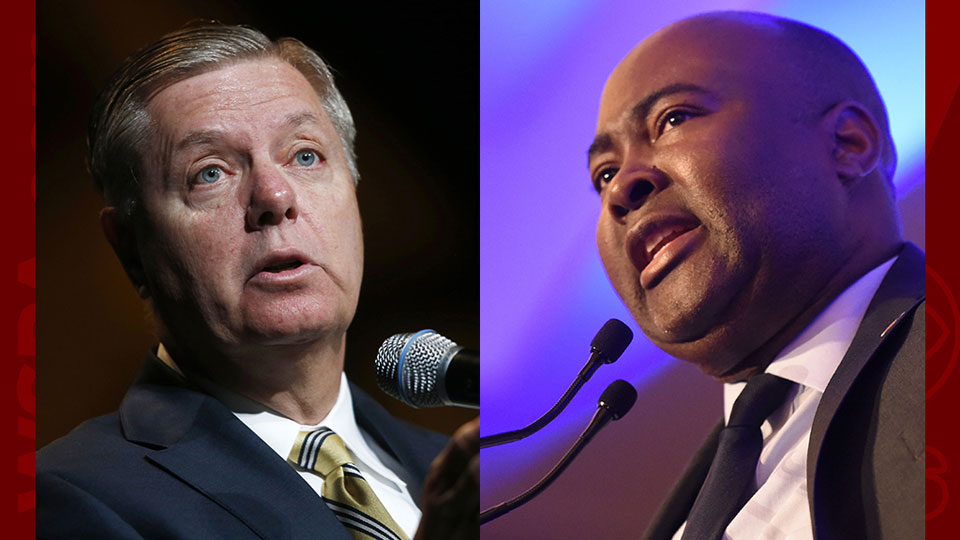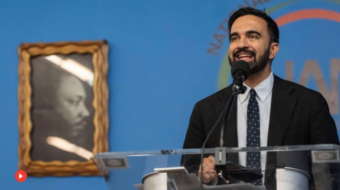
WASHINGTON —Lindsay Graham never expected this. Nor did Steve Daines. Or Martha McSally.
With less than a month to go until Election Day, those Republican senators, from South Carolina, Montana, and Arizona, respectively, are in the fights of their lives for political survival.
McSally trails former astronaut John Kelly by so much—11 percentage points in the latest poll—in now-“purple” Arizona that the national GOP may be ready to write her off. She trails Kelly in money in the bank, by $10 million, too.
And that gives you an idea of what the congressional outlook is like this year.
The combination of the coronavirus pandemic, the economic crash, the national demand for social, racial, and economic justice, and slavish GOP kowtowing to Oval Office occupant Donald Trump combined to tank vulnerable congressional Republicans’ polls.
The results show up on both sides of Capitol Hill. Republican senators are scrambling for re-election. Meanwhile, 26 of the 197 Republican House members, facing another two years in the minority, scrambled for the exit. Six of those sought higher office. The rest quit.
But only five of 232 House Democrats are retiring, as is the sole Libertarian, Justin Amash of Michigan, whom the GOP kicked out of the party for insufficient fealty to Trump. Four other Dems sought higher office, including failed presidential hopeful Tulsi Gabbard, D-Hawaii.
The Senate’s ruling Republicans hold 53 of the 100 seats, and almost a dozen of the 23 they’re defending are shaky or worse. Of the 45 Democrats, and the 12 U.S. Senate seats they’re defending, only Alabaman Doug Jones looks like a loss. Democratic-leaning independents Bernie Sanders of Vermont and Angus King of Maine aren’t up this year.
With Jones likely to lose to former Auburn football coach Tommy Tuberville in Alabama, the Democrats must pick up four GOP-held seats if Biden wins and five if Biden loses this fall to take control away from anti-worker Majority Leader Mitch McConnell, R-Ky., and his right-wing-dominated caucus. If Biden wins, his vice president, Kamala Harris, would be the tiebreaker in a 50-50 situation.
And even McConnell, for the first time in years, must tend to his own knitting in the Bluegrass State, thanks to a well-funded and energetic challenge from former military pilot Amy McGrath. She trails him by seven percentage points. McConnell won in 2014 by 15.5%.
Daines, McSally, and Graham aren’t the only endangered Senate Republicans. They’re just the unlikely ones. Ever since the start of 2020, Democrats targeted three other extremely vulnerable Republicans, besides McSally: Susan Collins (Maine), Thom Tillis (North Carolina), and Cory Gardner (Colorado). Maine and Colorado are blue states. North Carolina is purple.
Now add to that crowd Republicans Joni Ernst in Iowa, former Senate Majority Whip John Cornyn in Texas, McConnell, an open seat in Kansas and both Senate seats in Georgia, one of them a special election. McSally-Kelly is also a special election.
All the possibilities are enough to make Democrats, and their worker allies, salivate and produce a lot of campaign cash. The party’s Senate campaign finance committee out-raised its GOP counterpart, though hundreds of millions of dollars in corporate “dark money,” harvested by McConnell, are flowing to aid his vulnerable senators via the airwaves and in social media.
And for that “dark money,” the Republicans can thank Trump. So, for that matter, can the Democrats, though they don’t benefit from that tsunami of corporate cash. But Trump is such a divisive presence, and looms so large over the election, that he’s turned virtually each Senate race into a referendum on his reign, and opened small-dollar floodgates for Democrats.
The Republicans tied themselves to Trump from Day One on Jan. 20, 2017. Now he’s nationalized the election thanks to key issues he’s polarized: Backing white nationalists and shoot-first cops, stacking the federal courts with right-wingers, repealing the Affordable Care Act and trashing workers’ rights. But with Trump still behind in the polls by anywhere from eight to 14 percentage points nationwide, many Republicans may sink with him, too.
Consider Graham, for example. He got some high-profile publicity on Oct. 12-13 as chair of the Senate Judiciary Committee and its hearing on Trump’s latest nominee to the U.S. Supreme Court, federal appellate judge Amy Coney Barrett. Senate Republicans, marshaled by McConnell, seated two prior right-wing Trump nominees, Neil Gorsuch and Brett Kavanaugh, on the High Court, and hundreds of other federal lower court judges, including Barrett.
Judgeships, key to legally overturning everything from the Voting Rights Act’s teeth to the ACA to reproductive rights, are red meat to the white religious right, a powerful bloc in Graham’s Palmetto State and overall in the Republican Party. But pushing through judges and opposing unions are not enough to guarantee the South Carolinian another six-year term.
He’s locked in a dead heat, 48%-48%, with former state Democratic Chairman Jaime Harrison. Harrison, who is Black and running in the state that began the Civil War, trails in cash on hand, with $10.23 million to Graham’s $15.37 million in a state where TV time is relatively cheap. Graham raised half his $29.9 million from big givers, while Harrison garnered 58.6% of his $28.8 million from small donors. Note that unusual virtual tie in garnering cash.
So what else accounts for the tie? Well, Trump, for one. In a brief 2016 presidential run himself, Graham was Trump’s most caustic critic. Since Trump won the GOP nod, Graham’s become his constant golfing buddy, even closer to the Oval Office denizen than McConnell.
Trump leads Democratic presidential nominee Joe Biden in deep-red South Carolina, the least-unionized state, 50%-44.6%. In 2016, he beat Hillary Clinton there, 54.9%-44.7%.
That smaller Trump margin lets workers line up behind Biden and Harrison, as Teamsters Local 509 business agent and political coordinator Sebrina Isom said during the state’s Democratic primary. Biden’s South Carolina win set him on the road to that nomination.
“We’re a right-to-work state here in South Carolina and it’s no joke,” said Isom. “It gets much harder to organize when you’re getting the police called on you for trying to talk to workers. We need a candidate who will stand up and make sure the NLRB is serving those who are trying to organize here in South Carolina. People shouldn’t have to be afraid or intimidated at work for trying to form a union.”
Biden has made support of strong unions and workers a key platform plank. Harrison knows the word “union” turns Carolinians off. So the former public high school teacher who started in poverty instead states on his website that “every American deserves the opportunity to earn a living wage and keep their family healthy. As senator, Jaime will fight to ensure there’s economic opportunity for folks like his [single] mom, who are willing to work.”
Now take the Graham-Harrison race and multiply it nationwide by ten, 11, or 12, and you have the situation in the U.S. Senate elections this fall.
In all of the close Senate-race states except Iowa and Texas, Trump trails Biden by anywhere from 3.5 percentage points to double digits. Trump easily won Iowa and took Texas in 2016, but trails by 1.1% in Iowa and leads by 1.7% in deep-red Texas, both within polls’ margin of error. Ernst trails by three and five (45%-50%) points against Theresa Greenfield (D). In the two newest polls, Cornyn tops Mary Jennings Hegar (D) 50%-42% and 48%-39%.
Kansas Democratic nominee state Rep. Barbara Bollier, an M.D. and former Republican, left the party over its stands against the Affordable Care Act (ACA) and for cuts in state school aid. She trails Rep. Roger Marshall, 50%-43% after prior polls showed them tied.
“This is one of those elections where you will see a difference with our country going forward or backward,” Teachers (AFT) President Randi Weingarten said in an outdoor event for the candidate in early October. “We need Dr. Bollier in the U.S. Senate.”
Colorado’s one-term Republican, Gardner, shot his credibility by being a down-the-line Trumpite, after promising to be an independent thinker. He backs Trump on 89% of votes. The GOP median is 92%. A flawed Democrat, former Gov. John Hickenlooper, who is more pro-business than many others in his party, keeps reminding voters of that broken promise.
Hickenlooper, like Biden, also stands for the ACA, with the public option added. Like Trump, Gardner wants to kill it, with no replacement. Hickenlooper had to fight off a tough progressive challenge in the Democratic primary. As a result, he trails Gardner by a 3-to-1 ratio in cash on hand—and leads him in the polls by 52%-42%.
Just before the state Democratic convention, the Denver Area Labor Federation backed Biden and Hickenlooper. Like other conventions, the Denver Fed met via Zoom due to the coronavirus.
“We’re proud to stand with our endorsed candidates because they stand with working families. We are no longer content with candidates who simply provide platitudes to our members,” Denver Federation President Josh Downey said then.
“We are demanding candidates we support take bold stands on collective bargaining, job creation, higher wages, affordable housing, a just transition for workers, and improving our schools. The workers who make the Denver metro area great deserve leaders who will help them build an economy that works for everyone and not just the wealthy few. And we look forward to working with those newly elected leaders after the election this fall.”
Daines loves Trump in deep-red Montana, but the state’s most popular politician, term-limited Gov. Steve Bullock (D), is his foe. They’re tied in one of the two latest tallies: 47% Daines, 48% Bullock, with a 4.8% margin of error. Both emphasize they can work with both parties.
Bullock touts getting Medicaid expansion—a top Democratic cause—through the heavily GOP legislature. Montana is huge, media-cheap, and thinly populated. Daines has $9.5 million and Bullock $7.5 million in a state where retail politicking, virus or no virus, is vital.
In Maine, Collins blew her moderate, independent image out of the water by backing the Trump-GOP tax cut in 2017 and providing the key GOP vote for Trump Supreme Court nominee Kavanaugh last year, dismissing credible sexual assault testimony against him from a very upset and reluctant Professor Christine Blasey Ford.
After that, outraged women and progressives raised at least $3.5 million to present to the Democratic primary winner, who turned out to be House Speaker Sara Gideon, a strong candidate and pro-choice champion. NARAL hosted her for a briefing and has hit the hustings.
The future of the Postal Service is also a key issue in highly rural Maine, and the state AFL-CIO says Collins is vulnerable on it. She sponsored and voted for the 2006 GOP-pushed postal “reform” law which put USPS in a $5 billion annual hole for pre-funding future retirees’ health care benefits. Without that unique debt, the USPS would be financially stable.
This year, Collins “helped set the stage for the current attacks on the Postal Service,” retired Letter Carrier John Curtis, an active member of the Maine State Association of Letter Carriers, told The Maine Beacon.
“She weakened the Postal Service to the point where people like our president can point to it and say, ‘There’s a crisis here,’” he added. Collins is trying to defuse the issue with a compromise offering USPS another loan to get through the coronavirus pandemic, which has smashed its top revenue source, first-class mail.
Gideon also outraised Collins by a 3-to-2 ratio, although Gideon had to use much of her money to win the primary. As of June 30, she had $5.4 million on hand, while Collins had $9.1 million. Gideon also had an average poll lead of five percentage points, outside the tallies’ margins of error. But two minor candidates garner 6%-10% of the vote, important in Maine’s ranked-choice voting system. It redistributes votes until someone wins an absolute majority.










